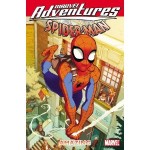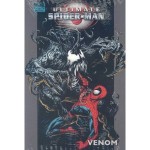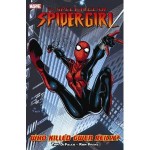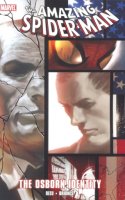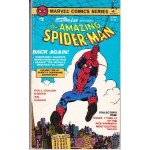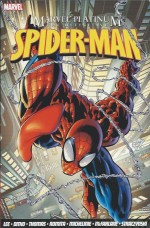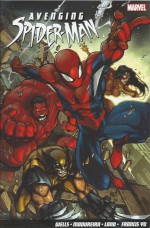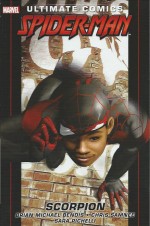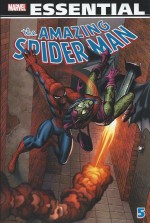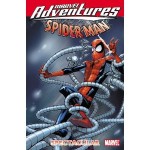
By Paul Tobin, Roberto Di Salvo, Jacopo Camagni, Ronan Cliquet, Amilton Santos & Terry Pallot (Marvel)
ISBN: 978-0-7851-4560-8
Since its earliest days Marvel has always courted the youngest comicbook audiences. Whether through animated movie or TV tie-ins such as Terrytoons Comics, Mighty Mouse, Super Rabbit Comics, Duckula, assorted Hanna-Barbera and Disney licenses and a myriad of others, or original creations such as Tessie the Typist, Millie the Model, Homer the Happy Ghost, Li’l Kids or even Calvin, the House of Ideas has always understood the necessity of cultivating the next generation of readers.
These days however, accessible child-friendly titles are on the wane and with Marvel’s proprietary characters all over screens large and small, the company usually prefers to create adulterated versions of its own pantheon, making that eventual hoped-for transition to more mature comics as painless as possible.
In 2003 the company created a Marvel Age line which updated and retold classic original tales by Stan Lee, Jack Kirby and Steve Ditko and combined it with the remnants of its failed manga-based Tsunami imprint, which was also intended for a junior demographic. The experiment was tweaked in 2005, becoming Marvel Adventures with the core titles transformed into Marvel Adventures: Fantastic Four and Marvel Adventures: Spider-Man and the reconstituted classics replaced by all-original yarns. Additional titles included Marvel Adventures: Super Heroes, The Avengers and Hulk. These iterations ran until 2010 when they were cancelled and replaced by new volumes of Marvel Adventures: Super Heroes and Marvel Adventures: Spider-Man which carried on the established continuities.
This digest-sized collection collects issues #5-8 of that second (2010) iteration and picks up where Spider-Man: Amazing left off. Paul Tobin continues scripting whilst 16-year old Peter Parker rounds out his first year as a reluctant – if driven – superhero: the mysterious Spider-Man.
Even after all the time he has prowled the streets and skyscrapers of New York, fighting crime and injustice, he’s still just a kid learning the ropes and pretty much in over his head all the time…
Illustrated by Roberto Di Salvo, the drama begins with the hero battered and close to death following his savage battle with manic assassin Bullseye. Meanwhile top gang enforcer Flip is still masterfully doing his illegal job, which he hates, especially all the lying to his wife – when big boss Berto Torino calls him in for a special mission.
Somewhere Spider-Man is holed-up and helpless. If Flip can find and finish the pestiferous punk there’s a $2 million pay-off up for grabs…
Across town Peter’s girlfriend Sophia Sanduval is frantic with worry. As a mutant who can communicate with animals and a part-time operative of the Blonde Phantom Detective Agency, “Chat†has got a lot of unusual resources at her disposal, but not even Wolverine and the X-Men can help her lost and wounded boy wonder…
Happily her bestial buddies make more progress. A horde of animals locate the unconscious wall-crawler and loyally cluster around his unconscious, recuperating form in a protective cordon…
Alerted by her birds, Chat rushes across town to his side, but the brutally efficient Flip is also closing in…
By the time she reaches Peter, the Mafioso is dealing with the severely battered wall-crawler – but her animal shelterers have already performed a redemptive miracle…
In school next day the bandage-bedecked Peter Parker is properly teased and quizzed by his class-mates, especially ex-girlfriend Gwen Stacy and her controversial new beau Carter Torino (her father is a New York cop who turns a blind eye to Parker’s vigilante sideline and the boy is the unwilling heir-apparent to the city’s paramount criminal empire).
Taking it all in stride, Peter also gets a stern talking-to from Chat and Police Captain George Stacy, both urging the guilt-fuelled hero to take it easy for a while. There’s little chance of that however, when a class trip to a museum is interrupted by murderous maniac Dr. Octopus…
When the still-sub-par Spider-Man leaps painfully into the fray, the furious Chat is forced to call in a favour and reinforcements by asking morally ambivalent psionic mutant Emma Frost AKA Silencer to take a telepathic hand in the affair…
An artistic fill-in by Jacopo Camagni, Ronan Cliquet & Amilton Santos sees a hilarious training session with Wolverine and ghostly X-Man Kitty Pryde turn into a bizarre comedy of errors when the Torinos try to buy off Spider-Man, whilst protestors (pro and anti) at a mutant rights rally are attacked by gun-toting gangsters afraid of losing their jobs to super-powered thugs-for-hire…
The flirty and fearsome Silencer rears her seductive head again in the final tale (art by Di Salvo & Terry Pallot), when Chat gets all snarky after refusing to introduce the increasingly bugged Peter to her enigmatic and never-seen older sister.
Burning with curiosity, Peter has trouble keeping within his boundaries, even after Chat helps him disastrously try out a new and “less-unlucky†heroic identity, but sparks fly when Silencer asks for their aid in taking out deadly mutant fire-starter Cinder and subsequently repays Chat by messing with Spider-Man’s obsessive mind…
These Spidey super stories are extremely enjoyable yarns, but parents should note that some of the themes and certainly the violence might not be what everybody considers “All-Ages Super Hero Action†and would perhaps better suit older kids…
Fast-paced and impressive, bright and breezy with lots of light-hearted action and loads of sly laughs, this book really sees the alternative web-spinner hitting his wall-crawling stride with the violence toned down and “cartooned-up†whilst the stories take great pains to keep the growing youth-oriented soap opera sub-plots pot-boiling on but as clear as possible.
Never the success the company hoped, the Marvel Adventures project was superseded in 2012 by specific comics tied to Disney XD television shows designated as “Marvel Universe cartoonsâ€, but these collected stories are still an intriguing and perhaps more culturally accessible means of introducing character and concepts to kids born sometimes two generations or more away from those far-distant 1960s originating events.
© 2010, 2011 Marvel Characters, Inc. All rights reserved.

